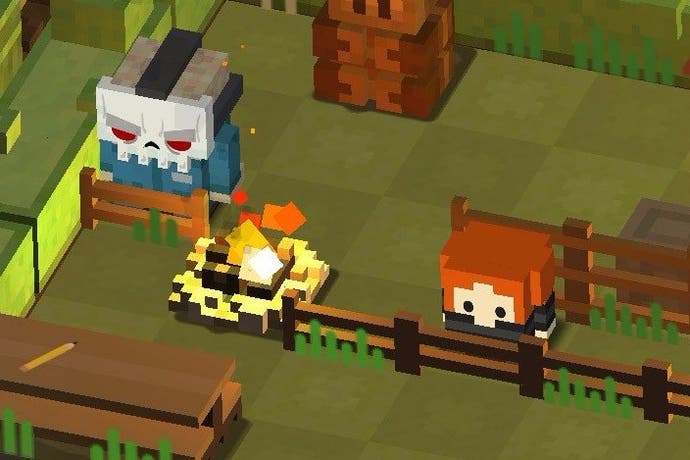Two 80s-inspired horror games that turn things a little bit Upside Down
Vorhee's behind you.
While we've been watching Stranger Things in my house - we're Team Barb to the bitter end, obv - I've been indulging my fondness for the 80s in other ways, too - namely with the build of an iOS game that has just, with brilliant timing, appeared on Kongregate, and with a funny little Ludum Dare offering that you can download over on itch.io. Both take the same 80s horror aesthetic and do clever things with it. One is in love with videotape, and the other is in love with audio cassettes. Lots and lots of 80s love.
Let's look at the videotape one first. Slayaway Camp is the new game from Nate Schmold, whose last offering sent players into space, naked, and asked them to plant flowers across the firmament. Cosmochoria was wonderfully wild and free-wheeling. Slayaway Camp is the exact opposite. You're a Jason-style spree killer, hacking up teens across a range of familiar schlock horror locations. But really, you're a marble rolling around inside a maze: your bloodlust has a spatial logic all its own.
In Slayaway Camp, you can only move in the four cardinal directions, and once you start going, you'll only stop if you hit a wall. This makes the game a real positioning challenge, as you are dropped into each level and have to read the lumps and bumps of the landscape in order to make it to your victims, and then make it back to the exit - which is, of course, marked by a pentagram.
I can't stop playing it, and not just because of the aesthetic, which uses blockish characters and pints of jagged 2D blood, all covered in the flickering and twitching of battered videotape noise. I love Slayaway Camp because of that central juxtaposition: the game that seems to be all about the unfettered rage of a rampaging monster is actually a precisely tuned brainteaser with a perfect solution hidden in each level. There's a little of Hitman Go to it.
The House Abandon is almost the inversion of this. Created by Jon McKellan, one of the designers behind Alien: Isolation, this is at first glance a model of economy and simple rules. You're presented with an old CRT monitor wired up to a home computer - the kind that ran games on cassette - and pretty soon you're playing a text adventure. Phrases like USE and GO TO "are your friends" according to the introductory text, and things seem pretty simple as you find yourself approaching an old family holiday home, working out how to get in, working out how to turn the lights on, and eventually finding your way to your old bedroom where a gift from your father is waiting.
Just as the game is settling into its groove, though - and which groove can be worn deeper than the world as made accessible through just a handful of commands? - The House Abandon flips things on their head. None of this is worth spoiling, inevitably - and the game's only a half-hour long, as is - but it's a dark delight to see that something that seemed so firmly on rails is all about the rails themselves, and all about - probably mangling the analogy here - the moment that you suddenly jump the track.
Both games work, I think, because of the resonance that goes along with such beautifully observed period detailing. Going beyond the fuzzy text on the CRT, and the loading screen of the game within the game in The House Abandon, say, and the Vorhees audio cues and machete-work of Slayaway Camp, both games hinge on the knowledge that the 1980s were the decade in which entertainment became deeply committed to the idea of genre: of conventions that must be observed, and cliches that must be repeated. The delight of Stranger Things itself - and this is possibly a spoiler? - is ultimately not that it subverts expectations, because we all spent a decade doing that, and wearing high-fastening pants, and that decade was called the 1990s. Stranger Things boldly plays things entirely straight. Do The House Abandon and Slayaway Camp play things straight too? In a way, yes - as long as you understand that they are working within the conventions of specific genres that you might not immediately expect them to fit into.



